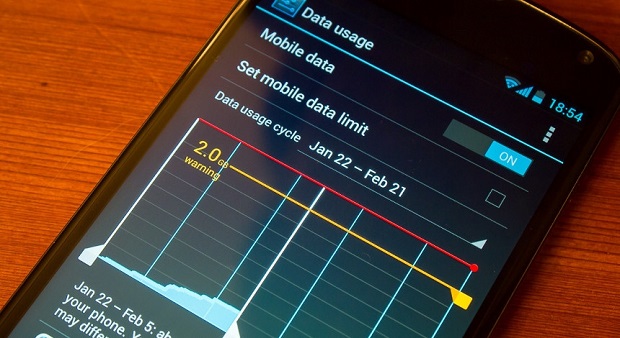E-Business
5 Ways to Maximise your Mobile Data Usage

Detailed analysis of mobile data usage suggests that connectivity rates remain comparatively pricey in Nigeria.
According to the Research and Development Unit of Yudala, Nigeria’s pioneer online and offline e-commerce outfit, data has thus become a very critical commodity that must be efficiently maximized, especially in view of the tiered data plans currently used by service providers.
With the growing popularity of social media, we are in age of information overload; one in which content is not only king but also predominantly ubiquitous.
In addition to music streaming, watching videos online and other activities that drain your data, most smartphones are also loaded with tons of data-hungry apps.
If not checked, you might find your mobile data bills burning a huge hole in your expense sheet on a monthly basis. The following tips from Yudala will come in handy for maximizing data usage on your smartphone:
Monitor your data usage
Most users live in fear of exhausting their mobile data before the expiration date, but with the help of some useful apps, you can now monitor and limit the amount of data used. The best way to save data is to be aware of the activities or applications that drain your cellular data. Most smartphones are equipped with data usage setting that enable you manage your data. Usually located in the Settings menu, you can set up alerts for when you exceed data usage for your most notoriously data-consuming apps.
Exercise caution with online video streaming
This is a known fact. But as much as we hate to admit it, the fun things consume most of your mobile data. Excessive streaming of videos, music, high quality images or GIF files, are things you need to avoid if you really want to maximize your internet usage. While we know these things are not entirely avoidable, there are some other ways to stay entertained responsibly. If you can’t avoid the entertainment your smartphone brings, you can set the quality at lower rates or decrease resolution in the settings menu of your smartphone.
Use Wi-Fi connection for updates or downloading heavy content
Wi-Fi is often regarded as a blessing by most smartphone users. While access to unlimited Wi-Fi connection is still rather limited in Nigeria, there are certain locations you can count on for free Wi-Fi. One of the most sensible ways of maximizing your mobile data usage is by setting up your smartphone for automatic updates only when on Wi-Fi connection. This way, you get to save some significant volume of the data drain that comes with auto-updates. Furthermore, downloads of heavy contents such as videos, high-resolution images and music files should also be done when on a secure Wi-Fi connection.
Restrict background data
Some applications use up a lot of data even when the phone is not in use. This is a brilliant feature of the smartphone: allowing background data to keep the applications on your phone updated. However, not every app needs to stay active at all times. You can stop the constant update by going to your settings option to select the app you want restricted or simply disable background app refresh in your settings. This helps reduce data consumption and also preserves the battery life of your device.
Preload and Cache
Despite the anxiety over cellular data, developers have made things easy and included options that make smartphone apps less demanding. A very good example is a cache, a hardware or software component that stores data so future requests for that data can be served faster. The data stored in a cache might be the result of an earlier computation, or the duplicate of data stored elsewhere These days, certain apps allow you to store data temporarily so you can cache as much content as possible. Caching is enjoyable on a Wi-Fi network which enables you enjoy preloaded content at any time, without using your cellular data.
E-Business
Cyberattacks: ‘56 Percent of Cases Stem from Existing Logins

A new report by Sophos, ybersecurity firm, has said that attackers primarily gained initial network access—56 per cent of all MDR and IR cases—by exploiting external remote services like firewalls and VPNs using valid credentials.

The 2025 Sophos Active Adversary Report details attacker behavior and techniques from over 400 Managed Detection and Response [MDR] and Incident Response [IR] cases in 2024.
According to the report, the combination of external remote services and valid accounts align with the top root causes of attacks.
For the second year in row, compromised credentials were the number one root cause of attacks [41% of cases]. This was followed by exploited vulnerabilities [21.79%] and brute force attacks [21.07%].
When analysing MDR and IR investigations, the Sophos X-Ops team looked specifically at ransomware, data exfiltration, and data extortion cases to identify how fast attackers progressed through the stages of an attack within an organisation.
In those three types of cases, the median time between the start of an attack and exfiltration was only 72.98 hours [3.04 days]. Furthermore, there was only a median of 2.7 hours from exfiltration to attack detection.
“Passive security is no longer enough. While prevention is essential, rapid response is critical. Organisations must actively monitor networks and act swiftly against observed telemetry.
Coordinated attacks by motivated adversaries require a coordinated defense. “For many organisations, that means combining business-specific knowledge with expert-led detection and response.
Our report confirms that organizations with proactive monitoring detect attacks faster and experience better outcomes,” said John Shier, field CISO.
The 2025 Sophos Active Adversary Report further reveals that attackers can move quickly, with a median of just 11 hours between initial access and a breach attempt on Active Directory, a critical asset in Windows environments.
Akira emerged as the most prevalent ransomware group in 2024, followed by Fog and LockBit, the latter still active despite a major takedown.
Attack detection has improved overall, with dwell time—the time attackers remain undetected—dropping from four days to just two, thanks largely to the inclusion of MDR (Managed Detection and Response) cases.
Dwell time varied depending on the type of case: it held steady at 4 days for ransomware and 11.5 days for non-ransomware cases in incident response (IR) investigations.
In contrast, MDR cases showed much faster response times—3 days for ransomware and just 1 day for non-ransom – ware attacks.
The report also highlights that 83% of ransomware deployments occurred outside local business hours, showing attackers favor overnight activity.
Additionally, Remote Desktop Protocol (RDP) was exploited in 84% of cases, making it the most commonly abused Microsoft tool.
To strengthen their cybersecurity posture, Sophos advises organizations to take several key steps.
First, they should close any exposed Remote Desktop Protocol (RDP) ports and implement phishing-resistant multifactor authentication (MFA) wherever feasible to reduce unauthorized access risks.
Additionally, companies should prioritize timely patching of vulnerable systems, especially those exposed to the internet. Deploying Endpoint Detection and Response (EDR) or Managed Detection and Response (MDR) solutions with 24/7 monitoring is crucial.
Finally, having a well-defined incident response plan—and regularly testing it through simulations or tabletop exercises—can greatly improve preparedness for potential attacks.
E-Business
Kaspersky Presents Insight on 14% Increase in Spyware Attacks on Businesses in Africa @ GITEX Africa

As part of the company’s participation at the GITEX Africa conference, taking place in Morocco on 14-16 April 2025, Kaspersky will address the dynamics for cyberthreats in the African region as per the latest anonymised data from the Kaspersky Security Network (KSN)¹.

From 2023 to 2024 businesses in Africa were targeted by web threats, on-device threats, and attacks aiming to steal data, including spyware and password stealers.
Phishing and ransomware continue to be significant threats in the region, with 66 million phishing link clicks seen by Kaspersky in the African region in 2024, including over 14.8 million phishing link clicks by corporate users.
Web-based threats, or online threats, are a category of cybersecurity risks that may cause an undesirable event or action affecting users browsing the Internet.
According to Kaspersky data, there were 131 580 587 web threats detected in 2024 in the African region, including almost 20 million attack attempts in Kenya, almost 17 million in South Africa, and 12.6 million in Morocco. Businesses were targeted by web threats more often in 2024 than in 2023, with threat detections increasing by 1.2%.
Local (on device) threats include malware that is spread via removable USB drives, CDs and DVDs, or that initially makes way onto the computer in non-open form (for example, programs in complex installers, encrypted files, etc.).
According to Kaspersky telemetry, local (on device) threat detections in organisations in the African region in 2024 increased by 4% compared to 2023. Among the countries that saw growth in local threats detected in organisations were Nigeria (169% increase), Ethiopia (86%), South Africa (32%), Senegal (11%), and Morocco (9%).
There has been a spike of threats related to data theft. According to Kaspersky data, there was a 14% growth in spyware attack detections on businesses in the African region from 2023 to 2024.
Spyware is secretly installed on a user’s computer to monitor their actions and collect their data. Apart from that, there has been a 26% increase in password stealer detections. Password stealers are a type of malware designed to harvest login credentials and other sensitive data.
“Our statistics show an increase in attack detections for several types of cyberthreats, and the factors driving these increases are multifaceted. In the B2B sector, the continuing shift toward hybrid work models and the rush to digitise operations — often outpacing cybersecurity investments — may leave businesses in Africa exposed to advanced persistent threats.
In the B2C space, the explosion of digital financial services, coupled with low digital literacy rates, makes individuals prime targets for opportunistic attacks,” comments Maher Yamout, Lead Cybersecurity Researcher with Kaspersky Global Research and Analysis Team.
“Organisations in Africa should prioritise a unified approach by enhancing collaboration, investing in specialised cybersecurity training, and promoting digital literacy to effectively combat the rising tide of cybercrime. Initiatives like the African Cyber Surge operation and targeted educational programs can serve as blueprints for building a resilient digital ecosystem across the continent.”
E-Business
Africa Plans to Establish a $60Bn AI Fund

A $60 billion Africa AI Fund is set to be established, leveraging public, private, and philanthropic capital. The goal is to build a secure, inclusive, and competitive African AI economy through foundational and catalytic investment, according to a declaration made at the recent Global AI Summit on Africa in Kigali, Rwanda.

The declaration seeks to leverage the potential of AI to drive innovation and competitiveness to advance Africa’s economies, industries, and societies. Second, to position Africa as a global leader in ethical, trustworthy, and inclusive AI adoption.
The declaration also seeks to foster the sustainable and responsible design, development, deployment, use, and governance of AI technologies in Africa.
The memorandum was facilitated by Qhala, Smart Africa, Rwanda’s Centre for the Fourth Industrial Revolution, and supported by the Gates Foundation.
Qhala is an AI enabler dedicated to driving innovation and digital transformation across Africa.
In a statement, Qhala said the declaration outlines shared commitment among African nations to align national strategies with continental goals, safeguard data sovereignty, build digital infrastructure, and foster a sustainable AI innovation ecosystem.
The organisation went on to say Africa’s AI landscape is changing at a fast pace and it is projected to contribute $2.9 trillion to the African economy by 2030.
Shikoh Gitau, CEO of Qhala, said: “This declaration is timely, as Africa’s AI ecosystem is rapidly evolving but remains fragmented and underfunded. This will ensure that Africa takes its place in a leadership role in global AI development.”
Lacina Koné, CEO of Smart Africa, added: “AI is not just technology to us, it’s an African arrow that, when thrown with the right ethical frameworks and inclusive policies, can pierce the way to African digital prosperity and resilience for the benefit of every citizen.”

 E-Business2 days ago
E-Business2 days agoCyberattacks: ‘56 Percent of Cases Stem from Existing Logins

 News2 days ago
News2 days agoSenate Committee Partners with Kuda Bank to Tackle Compliance Crisis as Nigeria Loses ₦3.4 Trillion

 E-Business2 days ago
E-Business2 days agoKaspersky Presents Insight on 14% Increase in Spyware Attacks on Businesses in Africa @ GITEX Africa

 Broadcasting2 days ago
Broadcasting2 days agoSubscriber Withdraws Suit against MultiChoice, FCCPC over Price Hike

 General News3 days ago
General News3 days agoAFD Commits €3m to Africa’s Financial Inclusion

 E-Financial3 days ago
E-Financial3 days agoVerve Expands Payment Frontiers with Global Partnerships, Contactless Innovation

 E-Financial2 days ago
E-Financial2 days agoSterling Bank Reiterates Transfer Fees Removal

 Telecom2 days ago
Telecom2 days agoMTN Plans Second Public Offer in Nigeria












